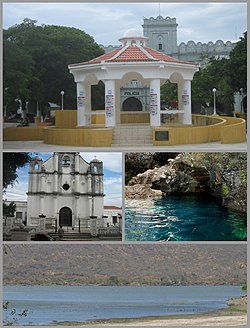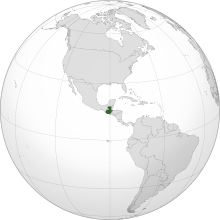
The national flag of Guatemala, often referred to as "Pabellón Nacional" or "Azul y Blanco" features two colors: sky blue and white. The two sky blue stripes represent the fact that Guatemala is a land located between two oceans, the Pacific Ocean and the Atlantic Ocean ; and the sky over the country. The white signifies peace and purity. The blue and white colors, like those of several other countries in the region, are based on the flag of the former Federal Republic of Central America.

The coat of arms of the Argentine Republic or Argentine shield was established in its current form in 1944 but has its origins in the seal of the General Constituent Assembly of 1813. It is supposed that it was chosen quickly because of the existence of a decree signed on February 22 sealed with the symbol. The first mention of it in a public document dates to March 12 of that same year, in which it is stated that the seal had to be used by the executive power, that is, the second triumvirate. On April 13 the National Assembly coined the new silver and gold coins, each with the seal of the assembly on the reverse, and on April 27 the coat of arms became a national emblem. Although the coat of arms is not currently shown on flags, the Buenos Aires-born military leader Manuel Belgrano ordered to paint it over the flag he gave to the city of San Salvador de Jujuy, and during the Argentine War of Independence most flags had the coat of arms.

The coat of arms of Bolivia has a central cartouche surrounded by Bolivian flags, cannons, laurel branches, and has an Andean condor on top.

The flag of El Salvador features a horizontal triband of cobalt blue-white-cobalt blue, with the coat of arms centered and entirely contained within the central white stripe. This design of a triband of blue-white-blue is commonly used among Central American countries. El Salvador's flag is one of few that currently use the color purple, due to the rainbow in its coat of arms.
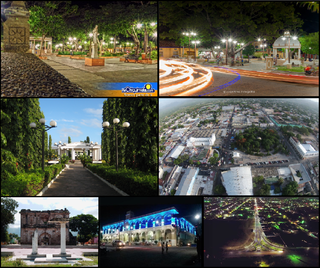
Chiquimula is one of the 22 departments of Guatemala, in Central America. The departmental capital is also called Chiquimula. The department was established by decree in 1871, and forms a part of the southeastern region of Guatemala. Physically, it is mountainous, with a climate that varies between tropical and temperate, depending on the location.

Guatemalans are people connected to the country of Guatemala. This connection may be residential, legal, historical or cultural. For most Guatemalans, several of these connections exist.

The coat of arms of Uruguay or Uruguayan shield was first adopted by law on March 19, 1829, and later on had some minor modification in 1906 and 1908. It was supposedly designed by Juan Manuel Besnes Irigoyen (1788–1865), based on the coat of arms of Argentina.
Concepción Las Minas is a municipality in southern Chiquimula department of Guatemala in Central America. It has a population of 11,693 (2018) and cover an area of 222 km2.
Asunción Mita is a town, with a population of 20,936 (2018), and a municipality in the Jutiapa department of Guatemala.
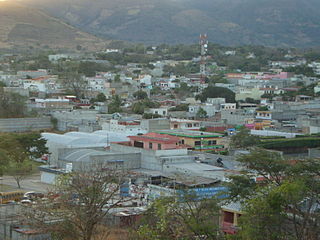
El Progreso, also El Progreso, Achuapa, is a town and municipality in the Jutiapa department of Guatemala. In 2018 the municipality had a population of 22,114 The Pan American Highway passes to the south of the main town, connecting it with Jutiapa, 11 kilometres (6.8 mi) to the southwest. The Morán, Chiquito and Ostúa rivers flow through the municipality. The main items produced locally include cigars, leather products, furniture, tiles and mud bricks.

Nueva Santa Rosa is a town and municipality in the Santa Rosa department of Guatemala. The municipality has a population of 36,464 and cover an area of 147 km2.
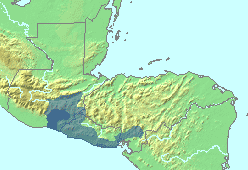
Xinca is a small extinct family of Mesoamerican languages, formerly regarded as a single language isolate, once spoken by the indigenous Xinca people in southeastern Guatemala, much of El Salvador, and parts of Honduras.
The Xinka, or Xinca, are a non-Mayan indigenous people of Mesoamerica, with communities in the southern portion of Guatemala, near its border with El Salvador, and in the mountainous region to the north.
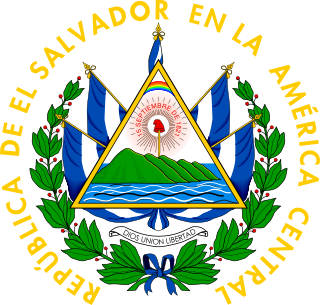
The coat of arms of El Salvador has been in use in its current form since 15 September 1912.
The Chʼortiʼ people are one of the indigenous Maya peoples, who primarily reside in communities and towns of southeastern Guatemala, northwestern Honduras, and northern El Salvador. Their indigenous language, also known as Chʼortiʼ, is a survival of Classic Choltian, the language of the inscriptions in Copan. It is the first language of approximately 15,000 people, although the majority of present-day Chʼortiʼ speakers are bilingual in Spanish as well.

Salvadorans, also known as Salvadorians, are citizens of El Salvador, a country in Central America. Most Salvadorans live in El Salvador, although there is also a significant Salvadoran diaspora, particularly in the United States, with smaller communities in other countries around the world.
Santa Catarina Mita is a town, with a population of 14,520, and a municipality in the Jutiapa department of Guatemala. The municipality cover an area of 207 km2 and has a population of 28,983.

An Afro-Guatemalan person is a person who lives in Guatemala, but has African decency in their historical and cultural roots. This term intertwines the conquest of America by the Spanish. The Afro-Guatemalan population is not numerous today. Although it is difficult to determine specific figures, it is reported that Afro-Guatemalans represent only between 1% and 2% of the country's population. According to the Council on Hemispheric Affairs. They are of mainly English-speaking West Indian (Antillean) and Garifuna origin. They are found in the Caribbean coast, in Livingston, Puerto Barrios and Santo Tomas. In the 17th century, many enslaved blacks were able to secure for themselves or at least their future children through marriage to free people. Many of these marriages were with Mayans or Europeans, which created a mix between blacks, Mayans and Europeans. This resulted in a significant mestizo population that, over the years, has continued to dilute traces of African ancestry in many cases. Today this can be referred to as Afro-mestizos due to miscegenation.
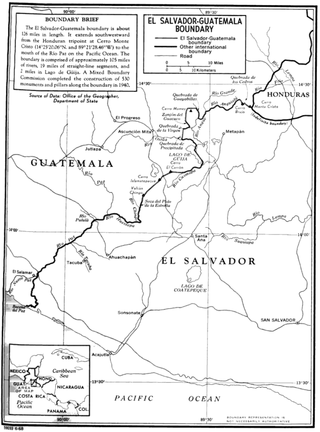
The El Salvador–Guatemala border is a 203 km (126 mi) international boundary in the northeast–southwest direction, northwest of El Salvador, and separating the country from the territory of Guatemala. From north to south, it starts in the triple border of the two countries with Honduras, near the peak Monte Cristo in Volcanoes National Park, extending to the southwest by the Pacific Ocean coast, following the final stage the Rio Paz. It separates the department of Jutiapa in Guatemala from Ahuachapan (north) and Santa Ana departments in El Salvador. It runs along 105 mi (169 km) of rivers, 19 mi (31 km) of straight-line segments and 2 mi (3.2 km) in Lake Güija. 530 boundary pillars were erected in 1940.
